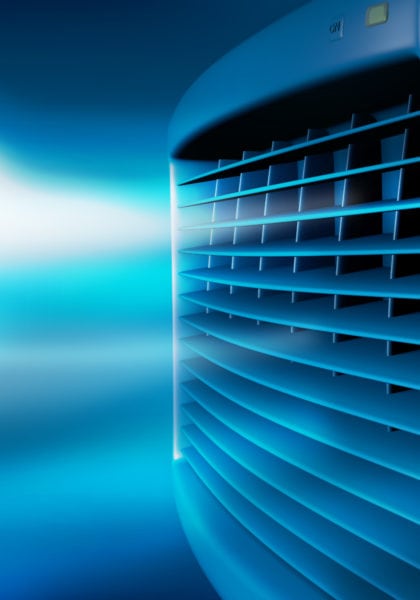Depending on the circumstances, swamp coolers may be able to provide many advantages over traditional air conditioning systems, even though swamp coolers are based on an ancient principle. To help you learn more about swamp coolers, this post goes over what swamp coolers are, how they got their name, and how they differ from air conditioning.
What Is a Swamp Cooler?
Swamp coolers rely on a process called evaporative cooling. In fact, an alternative name for a swamp cooler is an evaporative cooler. Chris Landers, writing for How Stuff Works, explains that you can see a miniature example of how a swamp cooler works just by wetting your finger and holding it in the air. The evaporating air will cool your finger off.
Ancient Egyptians made use of this process long before the invention of swamp coolers: They simply hung went blankets from the doors of their homes and let the air passing by act as a cooling mechanism. Higher-status Egyptians had servants fan them across water jugs, per Landers. This is replicated in modern times by the use of fans.
Here is the gist of the science behind this process: When a liquid evaporates, it turns into a gas, and it discards molecules, which go into the surrounding air. Those molecules absorb heat from the air, meaning that the air becomes cooler. Any liquid that remains cools off as well: The hotter the molecule, the more likely it is to slough off into the air. This process is particularly effective for cooling purposes because, according to Wikipedia, water takes on a “relatively large amount of heat” when it evaporates.
Swamp coolers put the process of evaporative cooling to work by making use of the aforementioned reaction. A swamp cooler contains a blower, which Landers describes as “a fan at one end of the box.” This fan’s function is to suck in air from the exterior of a building and pump it into the building it is meant to cool. However, before the swamp cooler lets the air into the house, the air moves through damp pads, which are kept wet by a pump.
The cooling power of a swamp cooler is determined by two temperatures: the wet bulb temperature and the dry bulb temperature. The dry bulb temperature is the same as the air’s normal temperature. The wet bulb temperature is what the temperature would be if the air reached a humidity level of 100 percent. Landers writes that the wet bulb temperature is measurable by wrapping a wet sock around a thermometer.
The dry bulb temperature is always the higher temperature of the two. A third measurement is the wet bulb depression, which is the amount left over after subtracting the wet bulb temperature from the dry bulb temperature. A swamp cooler operating at peak efficiency can reduce the temperature by, at most, 95 percent of the wet bulb depression.
How Did It Get Its Name?
A common question is how swamp coolers got their name. Unfortunately, there is no easy answer: As pointed out by the refrigeration and air conditioning company Mechanical Technologies, the source of the name is up for debate. A widespread theory, however, is that the name comes from the unpleasant, swamp-like odor that swamp coolers begin to generate without proper cleaning. Fortunately, regular maintenance can prevent swamp coolers from becoming odorous.
How is a Swamp Cooler Different from Air Conditioning?
Another common question is what differentiates swamp coolers from regular, run-of-the-mill air conditioners. For one, swamp coolers offer a number of advantages over normal air conditioners. Perhaps the most noteworthy advantage is the potential cost savings afforded by a swamp cooler. For installations, estimates suggest swamp coolers as being $1,100 cheaper on average, assuming the home is 1,500 square feet. Studies also advises that swamp coolers use between 15 and 35 percent less energy than similar-sized air conditioners, which can cut down on utility bills.
Another advantage of swamp coolers is that they are relatively quiet to operate when compared to air conditioning units, which can be quite noisy. Additionally, swamp coolers emit less carbon dioxide than air conditioners, adding to their environmental friendliness. Yet another mark in favor of swamp coolers is that unlike air conditioners, they do not recirculate the same air over and over. Instead, they draw new air into the building continually, meaning that the air stays fresh. Adding to this advantage is that with swamp coolers, doors and windows can stay open if desired. Typically, they must stay closed for an air conditioning unit to work at its best.
However, swamp coolers are not perfect. They offer less precise control than air conditioners. Swamp coolers also need to be regularly replenished with water to keep the cooling pads damp. It should be noted that air conditioning units require regular maintenance as well.
Despite their name, swamp coolers do not function as well in humid conditions: They do not cool as well and may make air that is already humid even more humid, which can lead to discomfort and, in extreme cases, the growth of mold or mildew. Traditional air conditioners have the opposite problem: If the air starts out dry, air conditioners can increase the dryness to an even more unpleasant level. That may dry the skin and cause discomfort in the eyes. Put another way, swamp coolers excel in dry, hot areas like Arizona, while air conditioners are better suited for humid climates.
Installing and Maintaining Swamp Coolers
Overall, swamp coolers are an excellent cooling solution, especially for people who want a quiet, efficient way to stay cool in a dry climate. Looking for a commercial evaporative cooler in the Phoenix area? Premier Industries would love to help. We create and install evaporative cooling systems to meet the needs of commercial, industrial, and residential clients. If you’re not sure where to start, don’t worry: Premier Industries provides consultations as well as customized solutions for each client.
